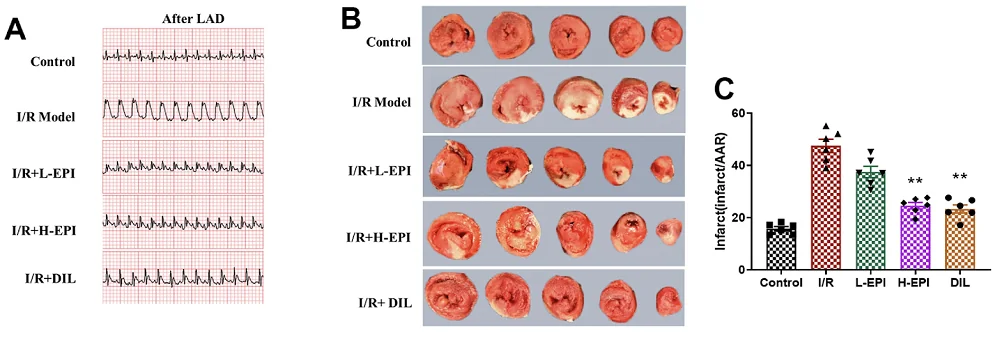A new study suggests that the flavonoid epicatechin, found in chocolate, tea, and berries, provides robust protection against reperfusion injury in myocardial infarction [1].
Reperfusion injury: friendly fire
Myocardial infarction (heart attack) is the injury caused by complete or partial cessation of blood flow to a portion of the myocardium, the heart’s muscle tissue. This, in turn, usually happens when arteries become blocked by atherosclerotic plaques due to aging and various lifestyle and environmental factors. Heart attacks are responsible for almost 700,000 deaths each year in the US, or one in five.
While the best course of action in the case of a heart attack is to immediately restore the blood flow, there is a catch: when blood rushes back to a previously oxygen-deprived tissue, it creates reperfusion injury, which accounts for about half of the total damage [2]. Hence, making the myocardium resistant to reperfusion injury can save many lives.
Strong protection
Myocardial infarction / reperfusion injury, or MI/RI, has been linked to increased inflammation. In this new study published in Aging, the researchers investigated the effects of priming rats with epicatechin, a flavonoid found in tea, cocoa, herbs, and other foods, on MI/RI. Flavonoids have been shown to have cardioprotective effects, explained at least in part by their potent anti-inflammatory and antioxidant activity [3].
Rats were given either 1 mg/kg or 2 mg/kg daily of epicatechin for 15 days prior to the myocardial injury. Diltiazem, a potent antihypertensive prescription drug, was used as a positive control, in a much higher concentration of 20 mg/kg/day.
Pre-treatment with epicatechin, especially with the bigger dose, provided robust protection against MI/RI. There was much less injury-associated arrythmia and inflammatory cell infiltration (white areas on the B image below). While in the untreated group, infarction affected about half of the myocardium, this number was much lower in the 2 mg/kg epicatechin group and basically on par with the positive control group.

The treatment also greatly improved antioxidant activity in the injured tissues, driving down the levels of destructive reactive oxygen species (ROS). Here, too, the higher dose was found to be considerably more effective.
When downregulating autophagy is a good thing
Injured myocardium is characterized by high levels of autophagy and ferroptosis, a type of iron-dependent cellular death. Autophagy is a beneficial process that clears out intracellular junk [4]. Increasing autophagy is thought to be a mechanism behind many longevity-promoting treatments. As a matter of fact, autophagy protects the heart from stress induced by factors such as energy deprivation.
However, in the specific context of MI/RI, excessive autophagy seems to be detrimental [5]. The 2mg/kg epicatechin treatment was effective in curtailing autophagy and ferroptosis – again on par with the positive control treatment.
To elucidate additional details of epicatechin’s protective effect, the researchers performed a number of experiments in vitro on H9C2 cells (a cell line derived from a rat embryo’s heart). Using high-resolution imaging, they captured the process of autophagic vesicles fusing with lysosomes for degradation. Treating cells with epicatechin induced dose-dependent autophagy downregulation.
Investigating how exactly catechin protects cells from reperfusion injury, the researchers found that the levels of several autophagy-related proteins were altered by the MI/RI-imitating treatment. In particular, it suppressed USP-14, an autophagy inhibitor. Treating the cells with the USP-14 inhibitor IU-1 abrogated the effects of epicatechin.
Epicatechin is a safe and widely available phytochemical, with benefits probably going far beyond the narrow context of myocardial infarction. Notably, the doses used in this study were relatively low (2 mg/kg translates to less than 200 mg for an average human, which can be obtained from supplements).
In the present study, a rat myocardial ischemia-reperfusion model treated with ligation and reperfusion of the left anterior descending coronary artery (LAD) surgery was established in vivo, and a hypoxic repletion treated H9C2 cell model was established in vitro to assess the protective effect of EPI on MI/RI. By analyzing the differences in the expressions of key proteins related to autophagy and ferroptosis, as well as changes in oxidative stress levels, the protective effect of EPI on MI/RI were revealed, and the mechanism by which EPI alleviates MI/RI was clarified, intending to explore a potential drug for the treatment of MI/RI.
Literature
[1] Junhong, K., Yun, T., Guangxing, S., Yuhan, D., Qian, X., & Haowen, Z. (2024). (-)-Epicatechin protects against myocardial ischemia/reperfusion injury via autophagy-dependent ferroptosis. Aging, 15.
[2] Frank, A., Bonney, M., Bonney, S., Weitzel, L., Koeppen, M., & Eckle, T. (2012, September). Myocardial ischemia reperfusion injury: from basic science to clinical bedside. In Seminars in cardiothoracic and vascular anesthesia (Vol. 16, No. 3, pp. 123-132). Sage CA: Los Angeles, CA: SAGE Publications.
[3] Khan, J., Deb, P. K., Priya, S., Medina, K. D., Devi, R., Walode, S. G., & Rudrapal, M. (2021). Dietary flavonoids: Cardioprotective potential with antioxidant effects and their pharmacokinetic, toxicological and therapeutic concerns. Molecules, 26(13), 4021.
[4] Barbosa, M. C., Grosso, R. A., & Fader, C. M. (2019). Hallmarks of aging: an autophagic perspective. Frontiers in endocrinology, 9, 790.
[5] Ma, S., Wang, Y., Chen, Y., & Cao, F. (2015). The role of the autophagy in myocardial ischemia/reperfusion injury. Biochimica et Biophysica Acta (BBA)-Molecular Basis of Disease, 1852(2), 271-276.




